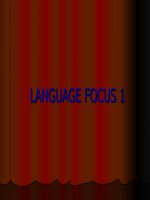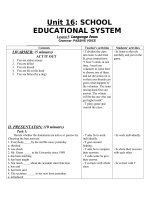unit 9: language focus( E 12)
Bạn đang xem bản rút gọn của tài liệu. Xem và tải ngay bản đầy đủ của tài liệu tại đây (1.11 MB, 24 trang )
Sắp xếp những từ sau thành câu có nghĩa
1. Is / a / she / student /
- She is a student
2. a / ‘s / student / she
- She’s a student
She is → It is full form
She’s → It is contracted form
Unit 9:
Lesson 5:
Thursday, January 20
th
, 2011
Full forms Contracted
forms
Full forms Contracted
forms
I am
You are
He is
She is
It is
We are
They are
I’m
You’re
He’s
She’s
It’s
We’re
They’re
I shall / will
You will
He will
She will
It will
We shall/will
They will
I’ll
You’ll
He’ll
She’ll
It’ll
We’ll
They’ll
Read the following phrases. Pay attention to how the full and
contracted forms of the auxiliaries are pronounced.
I. PRONUNCIATION:
Full and contracted forms of auxiliaries
I. PRONUNCIATION:
Full and contracted forms of auxiliaries
I. PRONUNCIATION:
- I think I’ll buy a motorbike
- You’ll notice that there’s a girl coming
- It’ll be much better if you could do it
- We’ll have to talk to her
- She’s feeling much better now
-
They’re students
-
He’ll be 17 next month.
Practise reading these sentences.
- I think I’ll buy a motorbike
- You’ll notice that there’s a girl coming
- It’ll be much better if you could do it
- We’ll have to talk to her
- She’s feeling much better now
-
They’re students
-
He’ll be 17 next month.
Practise reading these sentences.
Connectors
II. GRAMMAR:
- It began to rain, the girl opened her umbrella.
so
- It’s very cold, he doesn’t like wearing a
coat.
but
1. Conjunctions: so / but
It began to rain.
The girl opened her
umbrella.
He doesn’t like wearing a coat.
It’s very cold.
+ S + V …
S + V …
, so
, but
Meaning:
- so: Vì thế (showing a result)
- but: nhưng mà (giving a contrast idea)
Use:
“so/ but” are used to combine 2 independent clauses.
Form:
EX
Practice:
Add so or but and a comma where appropriate.
(Textbook – Page 103 )
Exercise 1.
Practice:
Exercise 1.
1. I didn’t have an umbrella __ I got wet.
2. I didn’t have an umbrella ___ I didn’t get wet
because I was wearing a raincoat.
3. The water was cold __ I didn’t go swimming.
4. The water was cold ___ I went swimming anyway.
5. Luan’s directions to his house weren’t clear ___ Binh
got lost.
6. The directions weren’t clear ___ Binh found Luan’s
house anyway.
7. Her friend lied to her ___ she still likes and trusts
him.
8. Her friend lied to her __ she doesn’t trust him
anymore.
, so
, but
, so
, so
, so
, but
, but
, but
Exercise 1. Add so or but and a comma where appropriate.
2. Conjunctive Adverbs: However
- It’s very cold, but he doesn’t like wearing a coat
- It’s very cold he doesn’t like wearing
a coat.
; however
Meaning: however: tuy nhiên
S + V …
, however,
; however
. However,
+ S + V …
. However,
, however,
Form:
Use:
“however” is used to combine 2 independent clauses.
It gives a contrast idea.
Note:
but = yet
Conjunctions Conjunctive
Adverbs
use
But Howevre
- Linking two independent
clauses
- Introducing a contrast idea
Following a
comma (,)
Following a
semi-colon (;)
or a period (.)
Followed a
comma (,)
Practice:
Exercise 2
Choose the suitable words. (Textbook – Page 104 )
Exercise 2. Underline the correct alternative in the following
sentences.
1. Dan didn’t study for the exam, however/but Lan did.
2. You could fly via Vienna; but/however it isn’t the only way.
3. They have lived next door to us for years, yet/however we
hardly ever see them.
4. My friend and I were tired, so/however we went home early.
5. We had wanted to stay until the end of the game, but/however
it got too late for us.
6. I understand your point of view. However/Although I don’t
agree with it.
7. The normal pulse for an adult is between 60 and 80 beats per
minute, so/but/however excitement will make a pulse much
faster.
8. The food didn’t look appetizing, but/however many people
started eating.
______
__
__
__
__
______
__
__
,
,
3. Conjunctive Adverbs: Therefore: vì thế, cho nên
Meaning: therefore: vì thế, cho nên
S + V …
; therefore
.
Therefore,
, there
fore,
+ S + V …
Form:
Use: “therefore” is used to combine 2 independent clauses.
It shows a result or consequence.
- It began to rain, so the girl opened her umbrella.
. Therefore,
, there fore,
- It began to rain the girl opened her
umbrella.
; therefore
Conjunctions Conjunctive
Adverbs
So There fore - Linking two independent
clauses
- Introducing a result
Following a
comma (,)
Following a
semi-colon (;)
or a period (.)
Followed a
comma (,)
Use
Practice:
Exercise 3
Add so, therefore or however where appropriate
1. He worked hard, _____ he could earn much money.
2. The shrimp was only 2 dollars a kilo this week, ______ I
bought three kilos.
3. He’s has been studying really hard, ______ he can pass the
exams.
4. She is still not good at Maths. ________ she cannot be the best
student in her class.
5. OK, you can take Chemistry as your major. _______ you
should remember that it is not easy to learn Chemistry.
6. The boy has chosen to do an MBA programme in Australia.
________ I think you should let him go.
7. It was already 6 p.m.,________ we closed the office and went
home.
8. Advertisers often say that their products are the best. _______
the real quality is not as good as it is advertised.
Exercise 3. Add so, therefore or however and a comma where
appropriate.
so
so
so
Therefore,
However,
Therefore,
so
However,
Conjunctions
Use
so
but
•
Linking two independent clauses
•
Introducing a result
•
Linking two independent clauses
•
Introducing a contrast idea
•
Following a
comma (,)
•
Following a
semi-colon (;)
or a period (.)
therefore
however
Conjunctive
Adverbs
•
Followed a
comma (,)
-
Do exercise B. Language focus
(Page 61 & 62 - Exercise book)
- Prepare: Unit 10 - Reading









